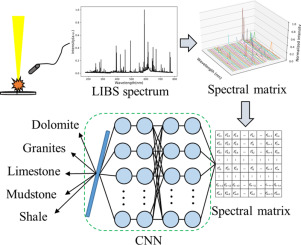当前位置:
X-MOL 学术
›
Spectrochim. Acta B. At. Spectrosc.
›
论文详情
Our official English website, www.x-mol.net, welcomes your
feedback! (Note: you will need to create a separate account there.)
Convolutional neural network as a novel classification approach for LIBS applications in lithological recognition
Spectrochimica Acta Part B: Atomic Spectroscopy ( IF 3.2 ) Pub Date : 2020-04-01 , DOI: 10.1016/j.sab.2020.105801 Junxi Chen , Jorge Pisonero , Sha Chen , Xu Wang , Qingwen Fan , Yixiang Duan
Spectrochimica Acta Part B: Atomic Spectroscopy ( IF 3.2 ) Pub Date : 2020-04-01 , DOI: 10.1016/j.sab.2020.105801 Junxi Chen , Jorge Pisonero , Sha Chen , Xu Wang , Qingwen Fan , Yixiang Duan

|
Abstract Rapid and accurate identification of multiple types of rocks using spectroscopic techniques has a wide market application prospect and is always challenging due to similar chemical composition and complex matrix effects. In recent years, laser induced breakdown spectroscopy (LIBS) coupled with supervised machine learning and chemometrics methods (e.g. k-nearest neighbor (kNN), support vector machine (SVM), partial least squares (PLS), artificial neural network (ANN)) and combined with feature engineering techniques (e.g. principal component analysis (PCA)), has demonstrated great capabilities for efficient identification of materials with similar chemical composition. To further increase the classification accuracy, LIBS coupled with a convolutional neural network with two-dimensional input (2D CNN) is here investigated for the identification of rock samples, including dolomites, granites, limestones, mudstones and shales. A regularized network structure was first designed, according to the performance of validation dataset, to enable the most reliable discrimination of the rock specimens. The accuracy of test dataset was then evaluated by the determined model. Results indicated that validation and test set of the 2D CNN was able to reach an accuracy of 0.9877 and 1, respectively. Finally, the performance was compared with other identification methods, including: one-dimensional convolutional neural network (1D CNN), kNN, PCA-kNN, SVM, PCA-SVM, PLS-DA, and Human-Assisted ANN (HA-ANN). The proposed approach has demonstrated that CNN has a great potential for the lithological identification and could be a feasible and useful tool for LIBS spectral data processing.
中文翻译:

卷积神经网络作为一种新的分类方法,用于 LIBS 在岩性识别中的应用
摘要 利用光谱技术对多种岩石进行快速准确识别具有广阔的市场应用前景,但由于化学成分相似,基质效应复杂,因此具有挑战性。近年来,激光诱导击穿光谱(LIBS)结合监督机器学习和化学计量学方法(例如k-最近邻(kNN)、支持向量机(SVM)、偏最小二乘法(PLS)、人工神经网络(ANN))并结合特征工程技术(例如主成分分析(PCA)),已经展示了有效识别具有相似化学成分的材料的强大能力。为了进一步提高分类精度,LIBS 与二维输入的卷积神经网络 (2D CNN) 相结合,用于识别岩石样品,包括白云岩、花岗岩、石灰岩、泥岩和页岩。根据验证数据集的性能,首先设计了正则化的网络结构,以实现对岩石标本的最可靠区分。然后通过确定的模型评估测试数据集的准确性。结果表明,2D CNN 的验证和测试集能够分别达到 0.9877 和 1 的准确度。最后,将性能与其他识别方法进行了比较,包括:一维卷积神经网络(1D CNN)、kNN、PCA-kNN、SVM、PCA-SVM、PLS-DA和Human-Assisted ANN(HA-ANN) .
更新日期:2020-04-01
中文翻译:

卷积神经网络作为一种新的分类方法,用于 LIBS 在岩性识别中的应用
摘要 利用光谱技术对多种岩石进行快速准确识别具有广阔的市场应用前景,但由于化学成分相似,基质效应复杂,因此具有挑战性。近年来,激光诱导击穿光谱(LIBS)结合监督机器学习和化学计量学方法(例如k-最近邻(kNN)、支持向量机(SVM)、偏最小二乘法(PLS)、人工神经网络(ANN))并结合特征工程技术(例如主成分分析(PCA)),已经展示了有效识别具有相似化学成分的材料的强大能力。为了进一步提高分类精度,LIBS 与二维输入的卷积神经网络 (2D CNN) 相结合,用于识别岩石样品,包括白云岩、花岗岩、石灰岩、泥岩和页岩。根据验证数据集的性能,首先设计了正则化的网络结构,以实现对岩石标本的最可靠区分。然后通过确定的模型评估测试数据集的准确性。结果表明,2D CNN 的验证和测试集能够分别达到 0.9877 和 1 的准确度。最后,将性能与其他识别方法进行了比较,包括:一维卷积神经网络(1D CNN)、kNN、PCA-kNN、SVM、PCA-SVM、PLS-DA和Human-Assisted ANN(HA-ANN) .











































 京公网安备 11010802027423号
京公网安备 11010802027423号